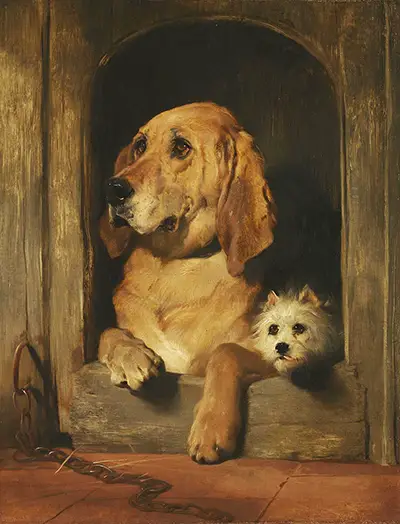 Buy Art Prints Now
Buy Art Prints Nowfrom Amazon
* As an Amazon Associate, and partner with Google Adsense and Ezoic, I earn from qualifying purchases.
Edwin Henry Landseer's paintings about dogs that he did during the 1830s are among the highly recognized works, and particularly his painting Dignity and Impudence has remained the most recognized and celebrated of all his dog paintings.
Majority of his works, including Dignity and Impudence, comprise of commissioned, life-size "paintings"; the others are based on independent subjects, normally using narrative content, and smaller in size. Edwin Henry Landseer in his painting, Dignity and Impudence wittily compares the scale as well as the character of bloodhound referred to as Grafton as well as a West Highland terrier known as Scratch. The two dogs were owned by Jacob Bell, who commissioned Henry Landseer to paint the picture. The painting's components depict the Dutch portrait culture, in which the subjects are framed across a window, while the arms or hands are stretching over the edge, similar to the bloodhound's paw hangs extended over the edge of the kennel.
Henry Landseer's Dignity and Impudence painting draw focus on the dogs' man-like features: the soulful appearance, as well as the gentle dignity of the bloodhound, is compared with the naughty appearance of the small terrier. In addition, the bigger dog was painted by Landseer using smooth, multicolored textures, whereas the little dog is painted with a few poking as well as indicative brushstrokes.
Edwin Henry Landseer contrasts various canine types using the same techniques in two different artworks, High life and Low life. However, these paintings depict a new kind of subject through its comical showcasing of the two dogs' connection. The artist went ahead to create similar literature in the stately and the hilarious in Lion and Dash as well as in the Lion Dog, both of which were produced during the 1840s. The earlier painting compares a Saint Bernard to a King Charles while the latter compares a Saint Bernard to a Maltese dog.
Grafton happened to be a once in a while visitor to a few painters' studios in London. In addition, he was a persistent creature with a genuine fighting spirit. At one point he was held in a stable with a different dog. Both dogs had taken a moment disliking one another, which led to a fight and were located on the following day badly injured and the opposite corners of the house. Bell, the owner of the dogs, became furious with the bloodhound and decided to leave him to die; however, the dog luckily survived the injuries and recovered. Bell seemingly favoured the terrier, and in fact, threatened to kill Grafton in case he misbehaved again.




